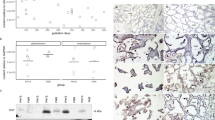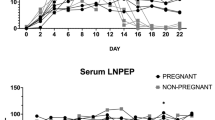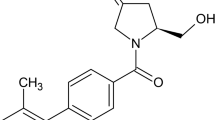Abstract
OXYTOCIN, a potent stimulant of myometrial activity, is used extensively in clinical practice for the induction of labour. The fact that in animals circulating concentrations of this peptide are increased during labour and maximal at the time of delivery1,2 suggests that oxytocin released by the maternal posterior pituitary may play an important part in spontaneous labour. The role of endogenous oxytocin, however, has been disputed. Bioassays suggest that the circulating concentrations are increased to 100 µU/ml. or more3,4, while indirect evidence suggests that there is no more than 10 µU/ml., and perhaps much less5.
This is a preview of subscription content, access via your institution
Access options
Subscribe to this journal
Receive 51 print issues and online access
$199.00 per year
only $3.90 per issue
Buy this article
- Purchase on Springer Link
- Instant access to full article PDF
Prices may be subject to local taxes which are calculated during checkout
Similar content being viewed by others
References
Fitzpatrick, R. J., and Walmsley, C. F., Advances in Oxytocin Research (edit. by Pinkerton, J. H. M.), 51 (Pergamon, London, 1965).
Folley, S. J., and Knaggs, G. S., Advances in Oxytocin Research (edit. by Pinkerton, J. H. M.), 37 (Pergamon, London, 1965).
Hawker, R. W., Walmsley, C. F., Roberts, V. S., Blackshawe, J. K., and Downes, J. S., J. clin. Endocrinol., 21, 985 (1961).
Coch, J. A., Brovetto, J., Cabot, H. M., Fielitz, C. A., and Caldeyro-Barcia, R., Amer. J. Obst. Gynec., 91, 10 (1965).
Theobald, G. W., Obst. Gynec. Survey, 23, 109 (1968).
Chard, T., Boyd, N. R. H., and Hudson, C. N., Intern. J. Obst., 8, 143 (1970).
Chard, T., Boyd, N. R. H., Forsling, M. L., McNeilly, A. S., and Landon, J., J. Endocrinol., 48, 223 (1970).
Hoppenstein, J. M., Miltenberger, F. W., and Moran, W. H., Surg. Gynec. Obst., 127, 966 (1968).
Chard, T., Kitau, M. J., and Landon, J., J. Endocrinol., 46, 269 (1970).
Chard, T., Forsling, M. L., James, M. A. R., Kitau, M. J., and Landon, J., J. Endocrinol., 46, 533 (1970).
Edwards, C. R. W., Chard, T., Kitau, M. J., and Forsling, M. L., J. Endocrinol., 48, xi (1970).
Somlyo, A. P., and Somlyo, A. V., Pharm. Rev., 22, 249 (1970).
Liggins, G. C., Kennedy, P. C., and Holm, L. W., Amer. J. Obst. Gynec., 98, 1080 (1967).
Liggins, G. C., J. Endocrinol., 42, 323 (1968).
Turnbull, A. C., and Anderson, A. B. M., Ciba Foundation Study Group No. 34 (edit. by Wolstenholme, G. E. W., and Knight, J.), 106 (1969).
Author information
Authors and Affiliations
Rights and permissions
About this article
Cite this article
CHARD, T., HUDSON, C., EDWARDS, C. et al. Release of Oxytocin and Vasopressin by the Human Foetus during Labour. Nature 234, 352–354 (1971). https://doi.org/10.1038/234352a0
Received:
Revised:
Issue Date:
DOI: https://doi.org/10.1038/234352a0
This article is cited by
-
Plasma vasopressin levels are closely associated with fetal hypotension and neuronal injury after hypoxia-ischemia in near-term fetal sheep
Pediatric Research (2020)
-
AVPR1A distribution in the whole C57BL/6J mouse neonate
Scientific Reports (2020)
-
Promoter methylation changes and vascular dysfunction in pre-eclamptic umbilical vein
Clinical Epigenetics (2019)
-
Development of the human hypothalamus
Neurochemical Research (1995)
-
Modulatory effects of neurohypophysary origin hormones on placental hormone secretion at term
Endocrine (1995)
Comments
By submitting a comment you agree to abide by our Terms and Community Guidelines. If you find something abusive or that does not comply with our terms or guidelines please flag it as inappropriate.



